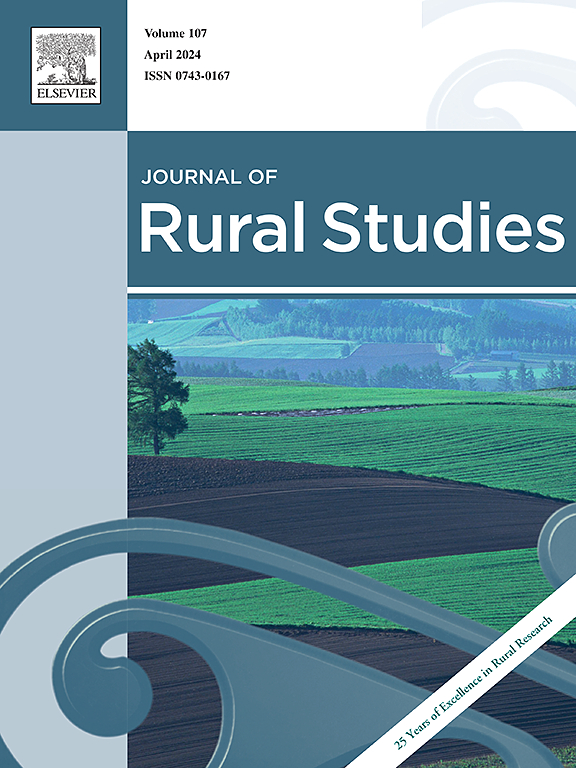“够了,我们喜欢我们的农场”:景观意识形态在塑造美国西南部农村太阳能和农业光伏观念中的作用
IF 5.1
1区 社会学
Q1 GEOGRAPHY
引用次数: 0
摘要
随着美国各地发展太阳能的努力越来越多,当地农村社区的反对声音也越来越大,那里的居民认为太阳能与当地的景观和身份不相容。认识到由于景观冲突导致公众对太阳能的反对日益增加,许多学者建议采用农业发电。这种共同利用的做法允许农业和太阳能生产在同一块土地上进行,作为提高公众对太阳能发展支持的解决方案。本研究利用美国西部的景观意识形态来研究太阳能如何适应不断变化的西部景观,并研究农业发电是否可以作为一种工具,更好地将太阳能开发与当地景观结合起来。这项研究的重点是亚利桑那州的皮纳尔县,这是一个历史上的农村农业社区,同时经历了城市化、农业生产下降和拟议的公用事业规模的太阳能项目的增加。通过对农民、政府官员和当地商业利益的半结构化访谈,结合对当地太阳能发展会议的参与者观察,我们发现皮纳尔县农民和政府官员在景观意识形态上的分歧显著地影响了对太阳能的反对。政府官员积极地认为,农业光伏是解决公众反对太阳能开发的一种解决方案,然而,农民对农业光伏的了解不足,太阳能开发商目前缺乏参与农业光伏实践的兴趣,这是皮纳尔县将农业光伏作为土地利用解决方案的关键障碍。最后,我们提出了增加农民参与农业光伏政策和项目开发的建议。本文章由计算机程序翻译,如有差异,请以英文原文为准。
“Enough is enough, we like our farms”: The role of landscape ideology in shaping perceptions of solar energy and agrivoltaics in the rural American Southwest
As efforts to develop solar energy increase across the US, so does local opposition in rural communities where residents view solar energy as incompatible with local landscapes and identities. Recognizing the growing public opposition to solar energy resulting from landscape conflicts, many scholars have recommended the adoption of agrivoltaics. This co-utilization practice allows for agricultural and solar energy production to take place on the same plot of land as a solution to improve public support for solar energy development. This study uses landscape ideologies of the Western United States to examine how solar energy fits into changing Western landscapes and investigates whether agrivoltaics can be used as a tool to better align solar energy development with local landscapes. The study focuses on Pinal County, Arizona, a historically rural agricultural community simultaneously experiencing exurbanization, a decline in agricultural production, and an increase in proposed utility-scale solar energy projects. Using semi-structured interviews with farmers, government officials, and local business interests in combination with participant observation of local meetings about solar energy development, we find that a divergence in landscape ideologies between farmers and government officials in Pinal County significantly shapes opposition to solar energy. Agrivoltaics is perceived positively by government officials as a solution to public opposition toward solar energy development, however, farmers’ insufficient knowledge about agrivoltaics and a lack of current interest by solar developers to engage in agrivoltaic practices present critical barriers to the use of agrivoltaics as a land-use solution in Pinal County. We conclude with recommendations for increasing farmer participation in agrivoltaic policy and project development.
求助全文
通过发布文献求助,成功后即可免费获取论文全文。
去求助
来源期刊

Journal of Rural Studies
Multiple-
CiteScore
9.80
自引率
9.80%
发文量
286
期刊介绍:
The Journal of Rural Studies publishes research articles relating to such rural issues as society, demography, housing, employment, transport, services, land-use, recreation, agriculture and conservation. The focus is on those areas encompassing extensive land-use, with small-scale and diffuse settlement patterns and communities linked into the surrounding landscape and milieux. Particular emphasis will be given to aspects of planning policy and management. The journal is international and interdisciplinary in scope and content.
 求助内容:
求助内容: 应助结果提醒方式:
应助结果提醒方式:


